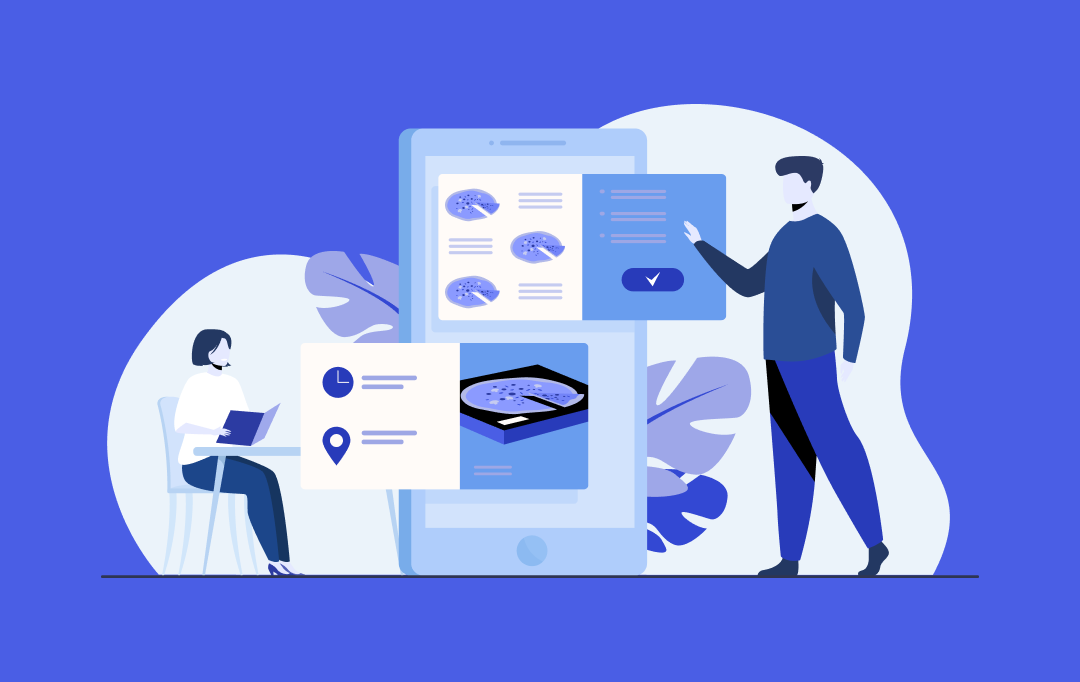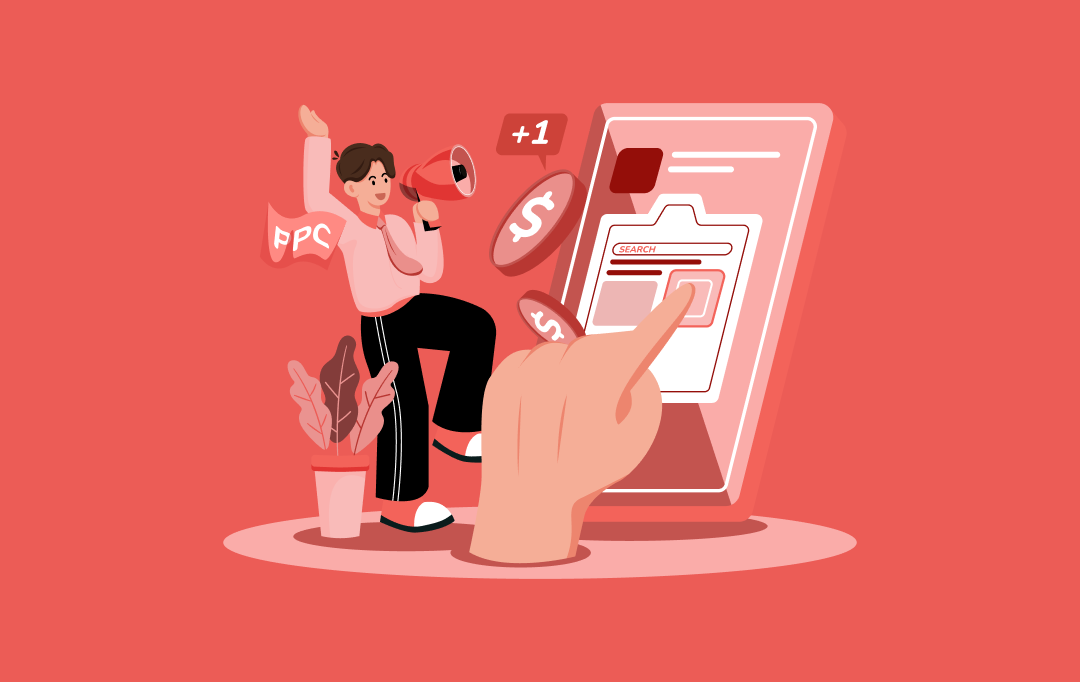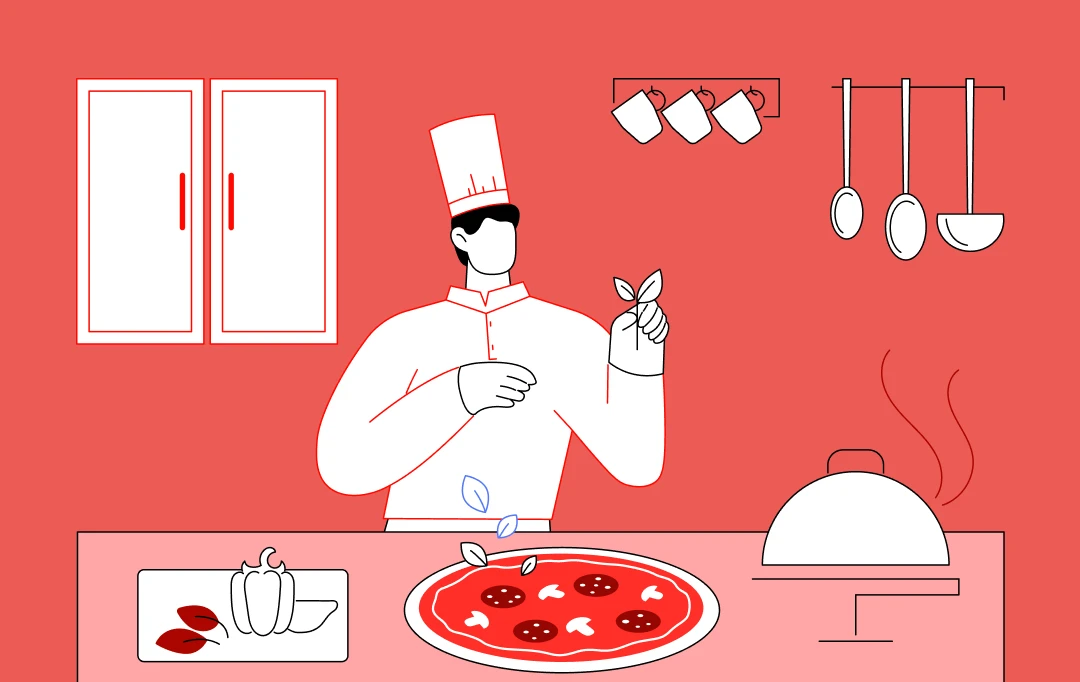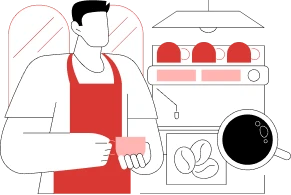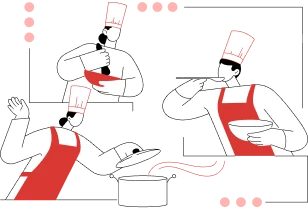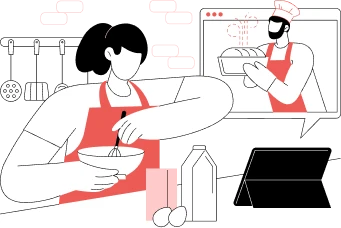- Understanding Cloud Kitchen Management Software
- Why Businesses Need Cloud Kitchen Management Software
- Step-by-Step Process to Build a Cloud Kitchen Management Software
- Step 1: Market & Requirement Analysis
- Step 2: UI/UX Design
- Step 3: Tech Stack Selection
- Step 4: MVP Development
- Step 5: Integration Phase
- Step 6: Testing & Quality Assurance
- Step 7: Deployment & Maintenance
- Key Features of a Cloud Kitchen Management System
- Order Management
- Inventory and Procurement Management
- Menu Management
- Kitchen Display System (KDS)
- Staff and Workflow Management
- Customer Relationship & Feedback Management
- Analytics & Reporting
- Integration Capabilities
- Cost of Developing Cloud Kitchen Management Software
- Key Cost Factors
- Ongoing Costs
- Challenges in Cloud Kitchen Management and How to Solve Them
- Managing Multi-Brand Operations
- Order Synchronization Across Multiple Platforms
- Inventory Mismanagement & Wastage
- Quality Control & Consistency
- Delivery & Dispatch Optimization
- Data Fragmentation & Lack of Unified Insights
- Compliance & Food Safety
- How to Find the Best Cloud Kitchen Management Software Development Company
- Evaluate Industry Experience
- Assess Technical Expertise
- Focus on UI/UX Design
- Check for Post-Launch Support
- Evaluate Transparency and Communication
- Compare Pricing with Value
- Future Trends in Cloud Kitchen Software
- AI-Driven Demand Forecasting to Predict Order Peaks
- IoT-Powered Kitchens for Temperature & Equipment Monitoring
- Cloud-Native Architecture for Seamless Scalability
- Predictive Maintenance to Reduce Downtime
- How Appinventiv Helps Build Next-Gen Cloud Kitchen Solutions
- FAQs
Key takeaways:
- Cloud kitchens are changing how food businesses work. They rely on delivery platforms, data, and speed instead of tables or fancy décor.
- A good management system keeps every part of the kitchen connected. Orders, inventory, staff, and deliveries all flow together in real time.
- Building the software is a step-by-step job. It starts with understanding how the kitchen runs, then moves through design, testing, and scaling.
- AI and IoT are shaping what comes next. They help predict demand, prevent waste, and keep quality steady across every location.
- The goal isn’t just automation, it’s growth. Smart cloud kitchen management software helps kitchens stay efficient as they expand.
Imagine your favorite meal arriving piping hot, yet the restaurant that made it has no tables, no waiters, and maybe not even a signboard. Just a kitchen tucked away in an industrial block, running purely on online orders.
That’s a cloud kitchen, and it’s quietly rewriting how the food business works.
These kitchens don’t care about location or décor. Their real currency is speed, data, and smart logistics. They cook not for footfalls but for delivery apps like Uber Eats, DoorDash, and Grubhub, where customers scroll, tap, and order in seconds.
The scale of it is staggering. Grand View Research estimates the global cloud kitchen market will hit $112.5 billion by 2030, growing at over 13% CAGR. In the US, it’s become a fast-moving wave — driven by people who want quick, varied, and affordable meals without waiting for a table.
Three things keep that wave rising:
- The dominance of delivery platforms
- Lower rent and staffing costs
- Data-backed menu planning and real-time performance insights
To stay ahead, restaurants and food entrepreneurs are now investing in custom restaurant management software alongside purpose-built cloud kitchen systems. By working with teams experienced in cloud kitchen management software development, they are able to automate workflows, gain better control over inventory, and ensure every order moves from the kitchen to the customer without delay.
82% of restaurant leaders are ramping up AI investments to boost kitchen efficiency — let’s make yours one of them.
Understanding Cloud Kitchen Management Software
A cloud kitchen management software is basically the control center for a virtual kitchen. Everything runs through it, new orders, menu edits, stock checks, and delivery updates, and managed from one simple dashboard.
It links with POS systems, delivery apps, and accounting tools so the routine stuff happens automatically. Orders get logged, ingredients stay tracked, and costs don’t go missing in the mix.
Cloud kitchens deal with higher order volumes, multiple brands, and dozens of moving parts. This kind of system is built exactly for that, to keep operations steady and make scaling feel less like a scramble, similar to how you build a food delivery app that handles high-volume orders.
Why Businesses Need Cloud Kitchen Management Software
Running a cloud kitchen without automation can quickly become chaotic. Operators often face:
- Manual order handling and delayed dispatches
- Poor inventory tracking and food wastage
- Data scattered across multiple systems
- No visibility into real-time performance
When these challenges compound, they affect everything from customer experience to profit margins. That’s why data-driven software has become essential.
With cloud kitchen management software, brands can:
- Streamline multi-brand operations from a single dashboard
- Access real-time data analytics on sales and performance
- Make faster, informed decisions based on live metrics
- Scale operations seamlessly across new cities or delivery platforms
Step-by-Step Process to Build a Cloud Kitchen Management Software
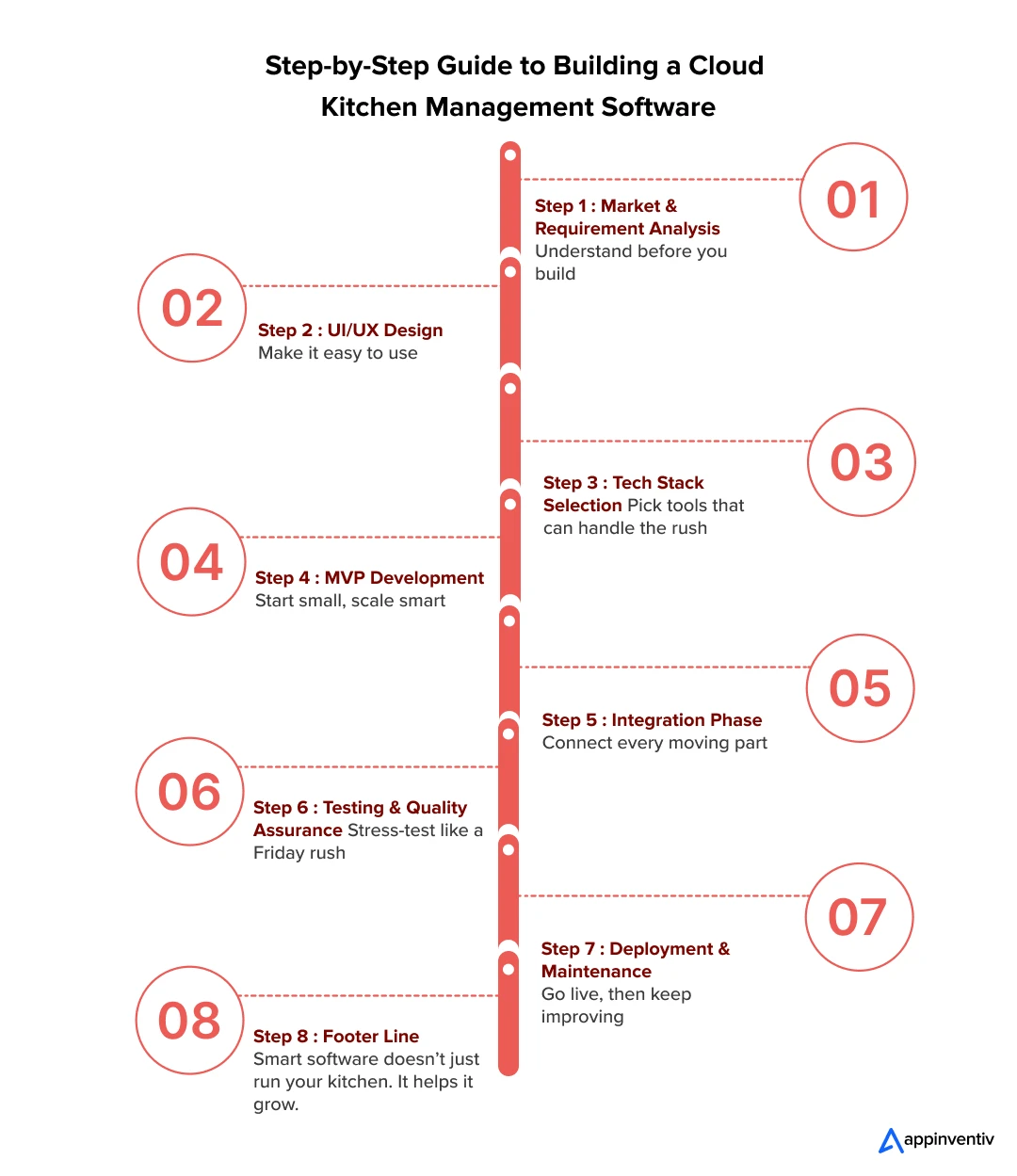
Running a cloud kitchen is really about coordination. Every order that goes out on time depends on how well the systems behind it work together — from order tracking and stock management to payments and delivery. When all those moving parts stay connected, the kitchen runs smoothly. That’s the goal of good cloud kitchen management software development.
To get there, you need a clear process. Each stage in the step-by-step process of cloud kitchen software development turns the day-to-day challenges of a kitchen into something structured, efficient, and easy to manage.
Step 1: Market & Requirement Analysis
Before building anything, it’s important to understand how the kitchen actually works. How do orders come in? What causes delays? Where does waste happen?
These questions shape a system that mirrors real operations instead of forcing people to adapt to the software. This groundwork helps create a platform that fits naturally, whether you’re running a single outlet or several virtual kitchens.
Step 2: UI/UX Design
In a busy kitchen, clarity saves time. The interface should show what matters most (live orders, available stock, and delivery status) all at a glance. A well-designed kitchen management system doesn’t need explanation. It should feel simple enough that anyone on the floor can use it without slowing down. When the design gets out of the way, the kitchen moves faster.
Step 3: Tech Stack Selection
The technology you choose decides how the platform performs when things get hectic.
Some of the key technologies in cloud kitchen management software include:
- Backend: Node.js, Python, or Java for strong data handling
- Frontend: React.js or Angular for clean and responsive screens
- Database: PostgreSQL or MongoDB for instant data access
- Cloud: AWS, Azure, or GCP for reliability and easy scaling
To successfully plan your cloud kitchen management system, you’ll need a detailed breakdown of software development cost covering design, development, testing, and deployment phases.
Step 4: MVP Development
Start with the essentials. Build a version that handles core functions like order tracking, inventory management, and analytics. Test it in real conditions, collect feedback, and refine it before adding advanced features. It’s like testing your first recipe before putting it on the menu.
This helps you create cloud kitchen management software that fits how your team actually works.
Step 5: Integration Phase
Modern kitchens depend on a web of tools like POS systems, delivery apps, supplier portals, and payment gateways. These should connect seamlessly so that data moves automatically between them.
A properly integrated delivery kitchen management system eliminates manual entry, lost orders, and reporting delays. Everything updates in real time, making operations predictable and stress-free.
Step 6: Testing & Quality Assurance
Testing keeps the kitchen running smoothly even under pressure. The restaurant kitchen management software should be tested like it’s a busy Friday night — with multiple orders, changing menus, and live payments.
Load testing, security audits, and workflow checks ensure every part of the system performs reliably. The goal is to make the software feel invisible: it works quietly while your team focuses on service.
Step 7: Deployment & Maintenance
Once ready, the system moves to a secure cloud setup and goes live. But the work doesn’t stop there. Kitchens evolve. New delivery partners join, menus change, and better tools appear. With ongoing support, your system stays current and reliable.
As part of our cloud kitchen management software development process, we help monitor performance, release updates, and keep everything running smoothly. The idea is simple — your software should grow with your kitchen, not hold it back.
Key Features of a Cloud Kitchen Management System
Every successful cloud kitchen runs on efficiency. And efficiency? That comes from the right technology. A well-built ghost kitchen management software or CKMS pulls together multiple tools into one system from orders to inventory, staff to analytics—all connected, all in real time.
Here’s what makes cloud kitchen software actually indispensable for any delivery-first business.
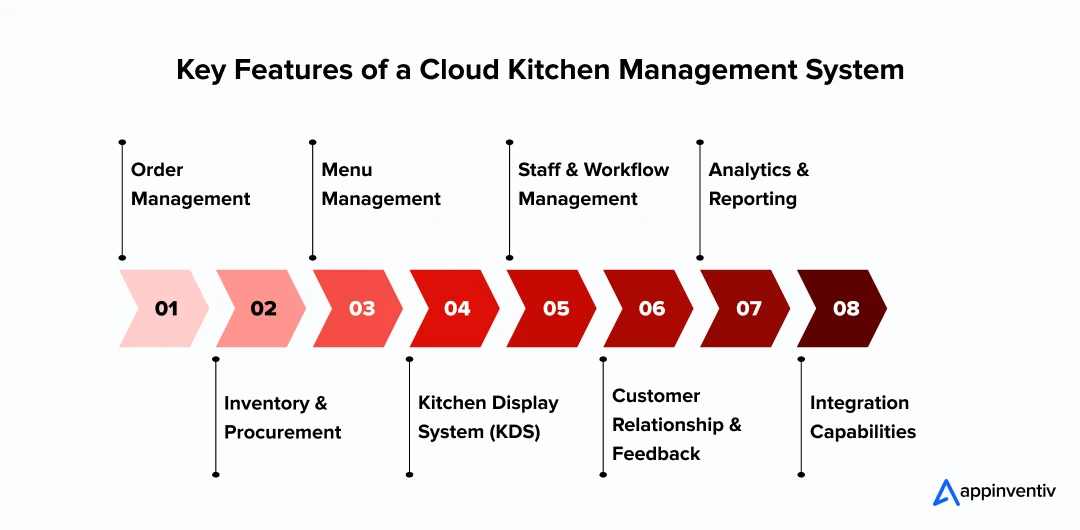
Order Management
Everything starts with an order. Whether they come from your website, apps like Uber Eats, DoorDash or Grubhub. Sometimes they all come in at once, and if you don’t have a system, the kitchen turns into chaos within seconds.
Cloud kitchen management software changes that, it pulls every order onto a single screen. The team sees what needs cooking, what’s up next, which kitchen handles what. Cooking time? Delivery distance? Rider availability? The system sorts it out on its own.
Not fancy, just functional. Orders move faster, with less chances of mistake. Everyone knows what’s going on without yelling over the fryer. And when the food shows up hot and correct, people come back to order again.
Inventory and Procurement Management
In a fast-moving kitchen, knowing what’s in stock isn’t a nice-to-have. It’s survival.
No one has time during a dinner rush to check if the tomatoes will make it through the night. A smart inventory system does the counting. Tracks usage. Flags what’s running low. Reorders before you hit zero.
Some advanced systems even use predictive analytics to tell you what you’ll need next week. They look at your past orders, what’s trending, what events are coming up. Not overstocking. Just staying ahead.
When vendor management lives inside the same kitchen management software, everything connects. You see supplier schedules. Approve deliveries. Set up auto-orders without switching tabs. It keeps things steady, cuts waste, saves time and money.
Menu Management
Cloud kitchen menus don’t sit still. They shift with demand, ingredient availability, and customer behavior.
Dynamic menu management lets you tweak items or change pricing across all delivery platforms from one spot. No hopping between apps. No duplication.
Want to test two versions of a combo meal? A/B testing tools show you which one sells. The restaurant kitchen management software pulls from order trends to highlight your high-margin dishes and guide smarter menu decisions. Less guessing. More data.
Kitchen Display System (KDS)
Paper tickets belong in the past.
A Kitchen Display System (KDS) gives you real-time visual dashboards instead—every active order, prep time, delivery sequence, right there. No miscommunication between front and back. Each order flows from prep to packaging without friction.
It can sync with delivery partners too, so customers get live updates. More visibility. Less “where’s my order?” drama.
Staff and Workflow Management
Scheduling and coordination? They decide how smoothly a kitchen actually runs.
Most cloud kitchen management software development includes shift management, attendance tracking, performance reports. Role-based access means your prep cook sees prep tools, your manager sees everything. Less clutter. Better security.
A solid virtual kitchen management system also balances workloads during peak hours to avoid bottlenecks. It’s not about keeping people busy. It’s about keeping them effective when it counts.
Customer Relationship & Feedback Management
Cloud kitchens miss out on face-to-face contact. That makes feedback even more important. The best setups use AI chatbots to handle simple customer inquiries, which frees up staff to focus on other tasks.
A built-in CRM collects ratings, reviews, repeat behavior—everything goes into one customer profile. That data drives personalized offers, loyalty perks, targeted campaigns and better customer retention.
Over time, those insights turn occasional buyers into regulars. That’s where the real growth lives.
Analytics & Reporting
Running a kitchen without analytics? You’re flying blind.
Modern cloud kitchen management software gives you real-time dashboards that visualize everything—sales, order times, waste, delivery performance. Advanced modules use predictive analytics to forecast demand, so you can plan staffing and purchases ahead of time.
Better decisions. Lower costs. Clearer picture of what customers actually want. Those are the real benefits of a cloud kitchen management system.
Integration Capabilities
No software works alone.
Seamless integration with your POS, CRM, ERP, and accounting systems keeps data flowing across departments. The best setups include secure API integrations that link delivery apps, payment gateways, vendor tools in one connected ecosystem. Some call it a kitchen management system.
With this seamless network, cloud kitchens scale across cities or brands without breaking.
Also Read: How Much Does Restaurant App Development Cost?
From food delivery to full-fledged cloud kitchen platforms, our restaurant app development expertise helps brands manage, automate, and grow smarter.
Cost of Developing Cloud Kitchen Management Software
There’s no single price tag for building a cloud kitchen platform.
A brand running one kitchen might only need a lean dashboard, a place to manage orders, check stock, and monitor performance.
Or they might be operating dozens of kitchens across cities, and want a full digital backbone that connects riders, analytics, and supply chains in real time.
That difference can put the cost anywhere between $40,000 and $400,000.
The cost doesn’t depend on the size of your kitchen, it depends on how much intelligence and automation you want baked into it.
According to Grand View Research, the global cloud kitchen industry is expanding at nearly 12% CAGR through 2030, pushing more brands to invest in advanced, data-driven systems rather than off-the-shelf tools.
That investment often starts with understanding where the money actually goes.
Key Cost Factors
- Number of Brands and Users
Running a single-brand kitchen is simple; one dashboard can do the job.
Add multiple brands, staff levels, or franchise units, and suddenly you’re dealing with layered permissions, cross-brand analytics, and centralized reporting.
Each layer adds both capability — and cost.
- Feature Set and Complexity
At the base level, you need order management, inventory tracking, and simple reports.
Scale that up with predictive analytics, IoT sensors that monitor temperature, or AI models that forecast ingredient demand, and the project gets much larger.
Every integration, POS, CRM, vendor system needs its own build time and testing window.
- UI / UX Design Depth
A kitchen interface has to work under pressure.
Designing something that gives staff real-time visibility without confusion takes research, prototyping, and iteration.
Good design doesn’t cost more because it looks pretty; it costs more because it prevents chaos later.
- Security and Compliance
Any platform handling customer data or online payments must comply with standards like GDPR or CCPA.
Adding end-to-end encryption, role-based access, and audit trails adds upfront effort, but it’s far cheaper than dealing with a breach.
- Developer Region and Rates
Where your development team is located still plays a big part in cost.
Typical hourly rates:
- US / Western Europe – $80 – $180 per hour
- Eastern Europe – $40 – $90 per hour
- South Asia – $25 – $60 per hour
The same build could vary by 2–3× depending on region.
Estimated Cost Range
| Build Type | What It Covers | Rough Cost Range |
|---|---|---|
| MVP / Pilot | Core modules – order, inventory, basic reports; built to test workflows and gather feedback. | $40 K – $70 K |
| Mid-Level Platform | Adds analytics, vendor management, POS / delivery integrations; suited for growing cloud kitchens. | $80 K – $200 K |
| Enterprise Solution | End-to-end automation with AI forecasting, IoT monitoring, and regional scalability. | $200 K – $400 K + |
These ranges come from developer-network data and verified estimates on Clutch and GoodFirms.
They cover discovery, design, development, testing, and initial deployment.
The real variable is how much of your vision you decide to build in the first phase.
Ongoing Costs
Once launched, the software becomes part of daily operations — it needs maintenance the same way a kitchen needs cleaning and restocking.
Here’s what usually shows up as recurring costs:
- Cloud hosting and data storage: $500 – $3,000 per month, depending on order volume
- Maintenance and version updates: 15 – 25 % of initial build cost per year
- API and third-party fees: payments, delivery tracking, maps, or notifications
- Security audits and compliance renewals: ongoing vulnerability checks
- Support and training: onboarding new staff or kitchens as you grow
These expenses keep the platform reliable as orders and data scale up.
In the end, the cost of building cloud kitchen software depends less on coding hours and more on clarity of scope.
Start lean, prove the model, and grow in layers.
That’s how most successful cloud kitchens build technology — one stage at a time, guided by what actually works in their kitchens, not just what looks good on paper.
Also Read: How Much Does It Cost to Develop a Custom Software for Your Business?
Challenges in Cloud Kitchen Management and How to Solve Them
Scaling a cloud kitchen isn’t just about cooking well — it’s about aligning systems, data, and operations so nothing falls through the cracks. Below are major cloud kitchen software challenges faced in the U.S. and strategies (backed by 2025-era research) to address them.
Managing Multi-Brand Operations
When a single kitchen supports multiple virtual brands, resource contention becomes a constant issue. Ingredient usage, staffing, order routing — everything must be isolated yet coordinated. Without a coherent system, brands clash over limited kitchen assets.
Solution: Use unified backend platforms that allocate capacity dynamically across brands. The platform should monitor demand fluctuations, ingredient overlap, and brand priorities to reassign resources in real time.
This approach mirrors enterprise-scale operations discussed in Deloitte’s 2025 and beyond restaurant trends, where consolidation of digital systems is seen as critical to managing complexity in multi-unit operations.
Order Synchronization Across Multiple Platforms
Orders come from dozens of apps, DoorDash, Uber Eats, direct sites, and inconsistent timestamps, duplicates, and missing entries cause confusion. When orders arrive asynchronously, kitchens lose time reconciling channels.
Solution: Adopt real-time middleware or API bridging that merges orders from all platforms into a single queue with normalized timestamps. This ensures a single source of truth for dispatch, reduces mismatches, and supports timely decision-making.
Inventory Mismanagement & Wastage
Forecasting ingredient needs is notoriously tricky in delivery-first models. Overestimating leads to spoilage; underestimating leads to stockouts and failed orders. The margin pressure in food operations magnifies these swings.
Solution: Leverage AI-augmented demand prediction that ingests historical orders, seasonal trends, and real-time demand to guide purchase orders. Such systems reduce buffer stock and react dynamically to shifts. Research on restaurant tech trends in 2025 highlights that AI-driven inventory tools are one of the fastest-adopted capabilities in multi-location operations.
Quality Control & Consistency
When processes diverge across kitchens, brand identity fractures. Slight deviations in ingredient ratio or cooking time produce inconsistent outcomes, which chips away at trust.
Solution: Embed standardized recipes, visual SOPs, and cook-time constraints into the system so every location follows the same blueprint. Publish updates centrally and enforce version control.
Delivery & Dispatch Optimization
Delivery in dense urban areas means navigating traffic, rider availability, and timed windows. Inefficient routing not only slows down orders but can nullify the speed advantage.
Solution: Use dynamic routing engines that integrate real-time traffic, driver availability, and expected prep times. Reassign routes mid-journey as conditions change. This level of optimization aligns with tech trends where systems must act autonomously.
Data Fragmentation & Lack of Unified Insights
Most kitchens juggle POS systems, delivery dashboards, vendor portals, and CRM tools. When these live in silos, leaders lose high-level visibility on costs, performance, and anomalies.
Solution: Implement a unified data layer or analytics layer that ingests feeds from all systems and presents cohesive dashboards. This consolidated view enables trend spotting, margin leakage detection, and cross-channel insights.
Compliance & Food Safety
Multiple U.S. state and federal regulations demand precise temperature logs, sanitation records, and audit readiness. Manual tracking is error-prone and hard to scale.
Solution: Deploy IoT sensor networks (for temperature, humidity, etc.) linked to the dashboard so thresholds automatically trigger alerts and logs are recorded without human effort. This automation shifts compliance from reactive to proactive.
How to Find the Best Cloud Kitchen Management Software Development Company
Finding the right team to build your cloud kitchen management software isn’t about who has the flashiest proposal — it’s about who actually understands how a kitchen runs when things get busy.
A good partner will know what happens when ten delivery orders come in at once, when an ingredient runs out mid-shift, or when a POS update crashes at the wrong time.
That’s the kind of awareness you want behind your product.
Evaluate Industry Experience
Look for companies that have done this kind of work before — food delivery, logistics, restaurant tech, or anything with time-sensitive workflows.
They should know what it means to balance multiple orders, integrate with delivery platforms, and keep track of fast-moving data.
Don’t just read their website — ask to see what they’ve actually built.
Real projects and real results will tell you more than polished sales decks ever will.
Assess Technical Expertise
Building a kitchen system is very different from building a regular app.
You need developers who understand cloud-native infrastructure, know how to handle integrations with delivery aggregators, and can design systems that stay stable during peak hours.
If they can explain how they’ll keep your uptime high, or how they’ll handle scaling when you open your tenth location — that’s a good sign they know their stuff.
Focus on UI/UX Design
Every extra click in a busy kitchen is time lost.
That’s why design isn’t just about how it looks — it’s about how fast someone can move through the system without thinking.
Ask for demos. Watch how the interface behaves under pressure.
Can a chef see everything at a glance? Can a manager reorder ingredients in seconds?
If it feels smooth and natural, that’s the kind of design that works in the real world.
Check for Post-Launch Support
Once your software goes live, the real test begins.
Delivery APIs change, menu items expand, and bugs appear at the worst times.
A dependable partner will stick around — with regular updates, quick fixes, and proper monitoring in place.
You don’t want a one-and-done agency; you want a team that treats your platform like something living and evolving.
Evaluate Transparency and Communication
The best development teams don’t hide behind jargon or endless timelines.
They tell you exactly what’s happening, share progress openly, and loop you in when decisions matter.
Look for teams that work in short, clear sprints and show you updates regularly.
That rhythm of collaboration builds trust — and prevents surprises later.
Compare Pricing with Value
Everyone’s tempted to go with the lowest quote, but the cheapest option often costs more in the long run.
A rushed build, poor documentation, or weak architecture will keep coming back to bite you.
Instead of comparing prices line by line, compare the long-term value: who’s building for scale, who’s planning for security, who’s thinking about the next three years, not just the launch.
Let’s get started on your project.
Future Trends in Cloud Kitchen Software
As cloud kitchens mature, they’ll increasingly adopt technologies that shift them from reactive to predictive, from manual to autonomous. Below are emerging trends in cloud kitchen management software to watch and build for your system.
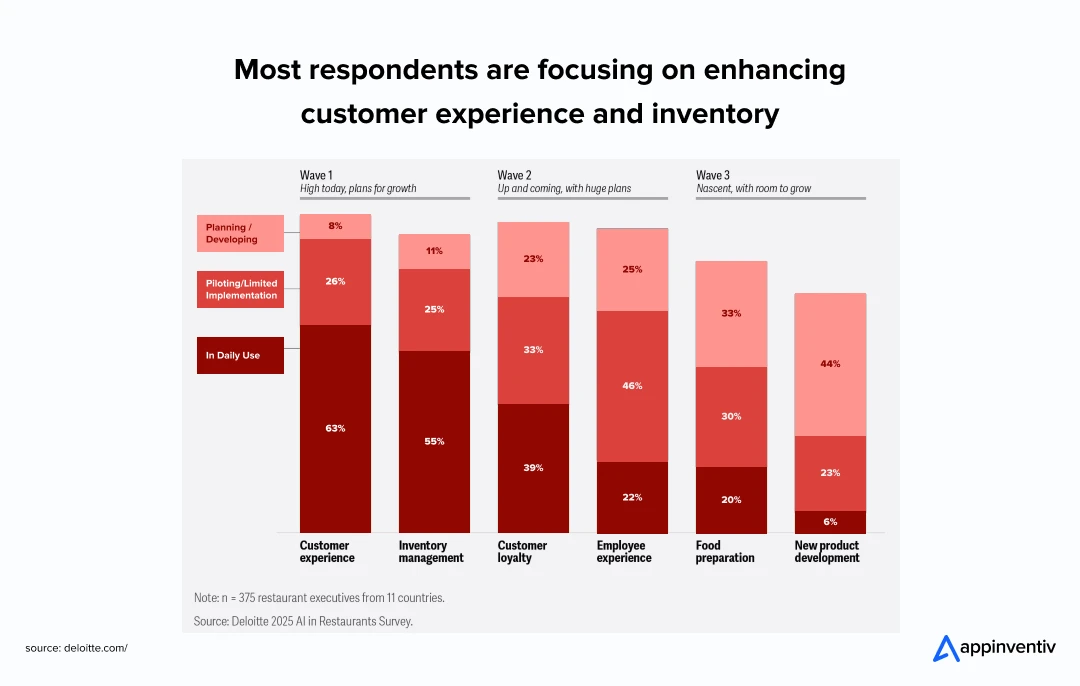
AI-Driven Demand Forecasting to Predict Order Peaks
Today’s kitchens often scramble to catch up when orders surge. The next generation won’t just react — it will anticipate, using sophisticated AI models for business to project hourly demand.
Using historical order data, local events, weather, and sales trends, AI models can project hourly demand, even days ahead. These forecasts allow kitchens to pre-prep, optimize staff allocation, and reduce bottlenecks.
According to Deloitte’s “How AI Is Revolutionizing Restaurants,” 55% of respondents report daily use of AI for inventory management, which includes forecasting and replenishment tasks.
IoT-Powered Kitchens for Temperature & Equipment Monitoring
Knowing whether a fryer is overheating or a refrigerator is drifting out of range in real time is no longer optional, it’s critical.
IoT sensors embedded in kitchen equipment can monitor conditions like temperature, humidity, and machine cycles. If a sensor flags an anomaly (e.g. cooler door left open, or an oven heating slower than usual), the system can alert staff immediately or auto-adjust settings.
Such real-time monitoring enhances food safety, compliance, and equipment lifespan. It also reduces human error in logging and audits.
Cloud-Native Architecture for Seamless Scalability
Legacy systems can’t handle spikes or expansion across new regions. Cloud-native design including microservice architecture, serverless, containerization enables backends that scale horizontally.
This means that when one kitchen has a surge, it can borrow computing power from others without service degradation. It also supports rolling updates, blue-green deployments, and regional failover — all necessary for a distributed cloud kitchen network.
Predictive Maintenance to Reduce Downtime
In a cloud kitchen, equipment failure is more than an inconvenience, it’s a halt in revenue.
By analyzing sensor data, usage patterns, and wear-level metrics, predictive maintenance models can flag when machines are likely to fail before they break. The system can schedule repairs or swaps in low-demand windows, avoiding surprise outages during peak hours.
This capability is becoming more mainstream as restaurants adopt IoT + AI stacks.
VR-Based Staff Training for Standardized Food Prep
Training consistency is a hidden factor in quality control. Imagine onboarding a new cook and giving them a VR simulation of the kitchen, guiding them step by step through recipes, shelf location, plating, and timing.
Virtual reality training can deliver immersive, repeatable simulations without tying up real kitchens or risking mistakes during live operations. It helps standardize workflows across locations and reduces the learning curve.
While less mature in restaurant tech, VR and AR are being explored in adjacent industrial and logistics applications. Deloitte places emphasis on how experiential technologies (VR/AR) might emerge in restaurants’ roadmap for workforce development. Deloitte+1
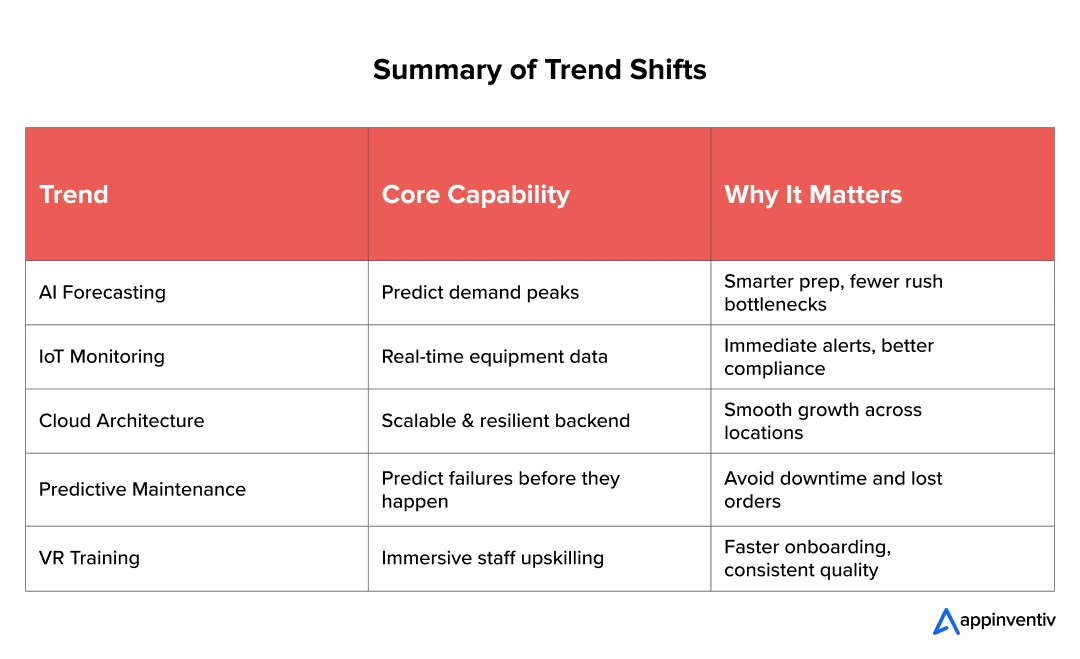
These trends don’t just look futuristic, many are already being piloted. The restaurants and kitchens that weave them into their roadmaps will have a real edge in efficiency, consistency, and resilience.
Also Read: How AI Is Transforming the Food Industry in 2025 and Beyond
How Appinventiv Helps Build Next-Gen Cloud Kitchen Solutions
At Appinventiv, we’ve always believed that good technology starts with understanding the people who use it. In food tech, that means knowing what happens inside a busy kitchen — the rush, the multitasking, and the small details that keep everything moving. Our expertise in restaurant app development services and cloud kitchen management software development focuses on building systems that simplify operations while leaving room for real-world flexibility.
Over the years, we’ve worked with brands like Domino’s and Kudu, helping them modernize how they manage customers, content, and scale. For Domino’s, the goal was to make ordering feel effortless — one tap, no friction. For Kudu, it was about giving the team full control of their platform, from updating menus to handling thousands of orders across locations. These projects shaped how we approach every new build, blending usability with reliability. While ensuring that each platform can handle both peak demand and everyday performance seamlessly.
Our cloud consulting services ensure that everything underneath, from architecture to integrations is built to last. We help businesses move from rigid systems to cloud-native setups that can adapt and grow as their kitchens expand. Each solution is designed, tested, and refined to keep operations stable, data secure, and teams confident enough to focus on what really matters — serving great food, fast.
Looking to build a cloud kitchen platform that’s efficient, scalable, and built for growth? Talk to our experts and turn your idea into a working system.
FAQs
Q. How does IoT integrate into a Cloud Kitchen Management System (CKMS)?
A. IoT just makes a kitchen smarter. Think of sensors that keep track of temperature, storage conditions, or equipment health without anyone checking every few minutes. When something’s off, maybe a freezer door isn’t shut properly, the system lets the staff know right away. It also helps with inventory. You can see what’s running low before it’s too late. These real-time insights are among the key use cases of cloud kitchen software, helping kitchens reduce waste, improve food safety, and stay consistent even during rush hours.
Q. How do delivery platform integrations benefit CKMS?
A. Most kitchens handle orders from several delivery apps at once. Without a proper link between them, it’s easy for things to slip. When the CKMS connects directly to apps like DoorDash or Uber Eats, everything lands in one place. No juggling screens, no double entries. The cooks get the right info, the orders go out faster, and customers see updates without anyone making a call. It’s simple, but it changes how calm the kitchen feels during a rush.
Q. What are the benefits of AI and Machine Learning in CKMS?
A. AI helps the kitchen make better calls without guessing. It looks at old order data, predicts what people will order next, and even helps plan how much to prep. Over time, it starts to spot patterns such as, which items sell fast, which ones slow down, and when peak hours hit. With these AI enabled benefits of cloud kitchen management system turn that data into small insights that save time and cut waste. It’s like having an assistant who quietly knows what’s coming next.
Q. How much does it cost to develop cloud kitchen management software?
A. There’s no one price that fits all. The cost of cloud kitchen management software development depends on how deep you want to go. A basic version with order tracking and stock control can start around $40,000. If you add AI forecasting, multi-brand dashboards, and integrations, it can go up to $200,000 or more. What really matters is building something that fits your kitchen, something that is reliable, scalable, and built to last longer than the next trend.


- In just 2 mins you will get a response
- Your idea is 100% protected by our Non Disclosure Agreement.
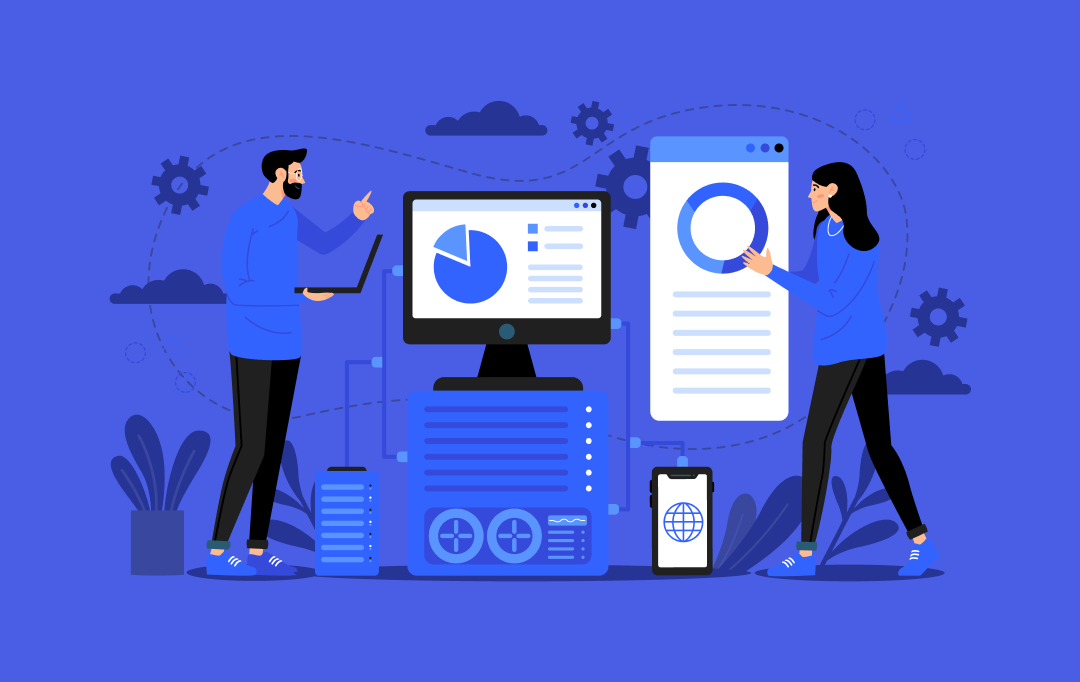
How Much Does It Cost to Build a White-Label Enterprise Procurement Software?
Key takeaways: The development of white-label enterprise procurement software typically costs between $50,000 and $500,000, depending on complexity and features. Key features include vendor management, budget tracking, purchase approvals, and invoice automation. Flexible monetization models - from modular licensing to integration fees- can future-proof revenue streams. Building a custom white-label solution gives you long-term control…
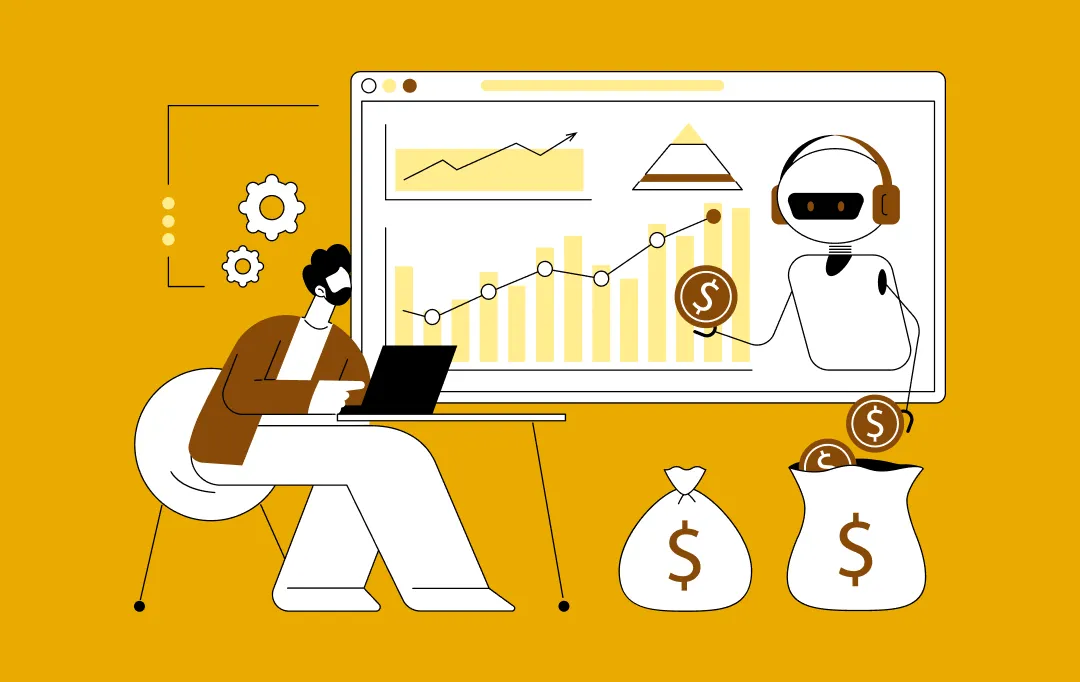
A Clear Breakdown of Custom Software Development Costs for Businesses in Canada
Key takeaways: Custom software in Canada typically ranges from CAD 55,00 to 550,000 ($40,000 to $400,000), depending on scope, integrations, and compliance. Costs rise in regulated sectors due to PHIPA, PCI DSS, AML rules, and strict Canadian data residency requirements. Planning, modular architecture, and cloud native services help control the software development cost in Canada…
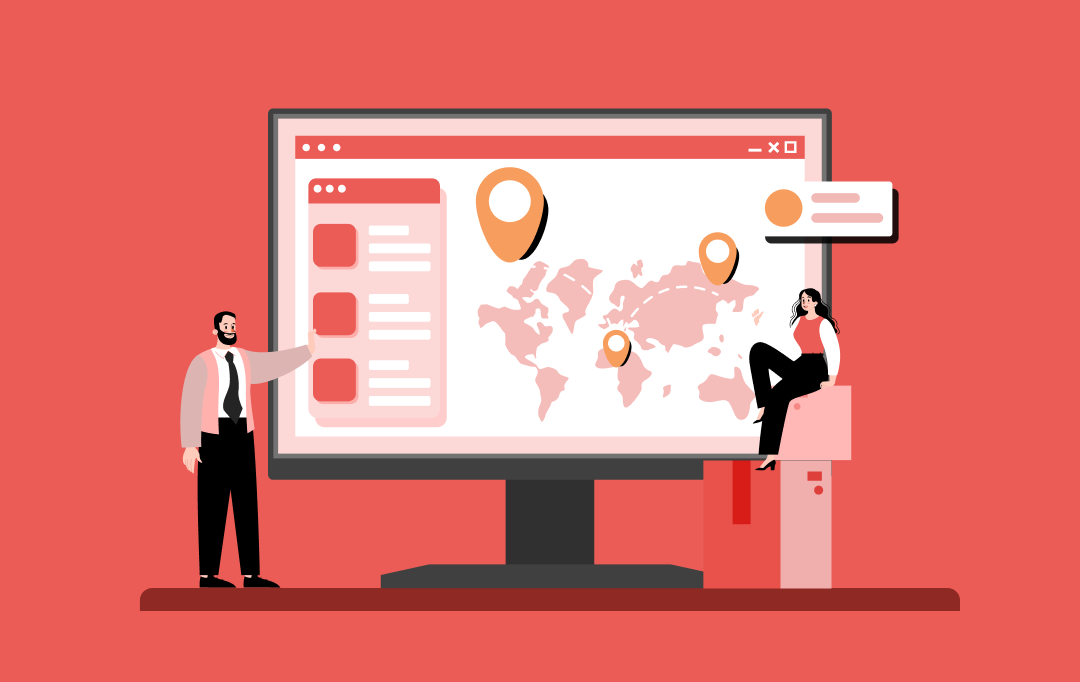
The Real Cost of Building Professional Delivery Management Software
Key takeaways: Custom delivery management software has complete flexibility, scale, and integration, which conforms to the distinctive requirements of business. Fluid connection to ERP, CRM, and payment systems also introduces a large amount of complexity and additional cost, but is the key to efficiency. It is important to design scalable systems to grow in the…











